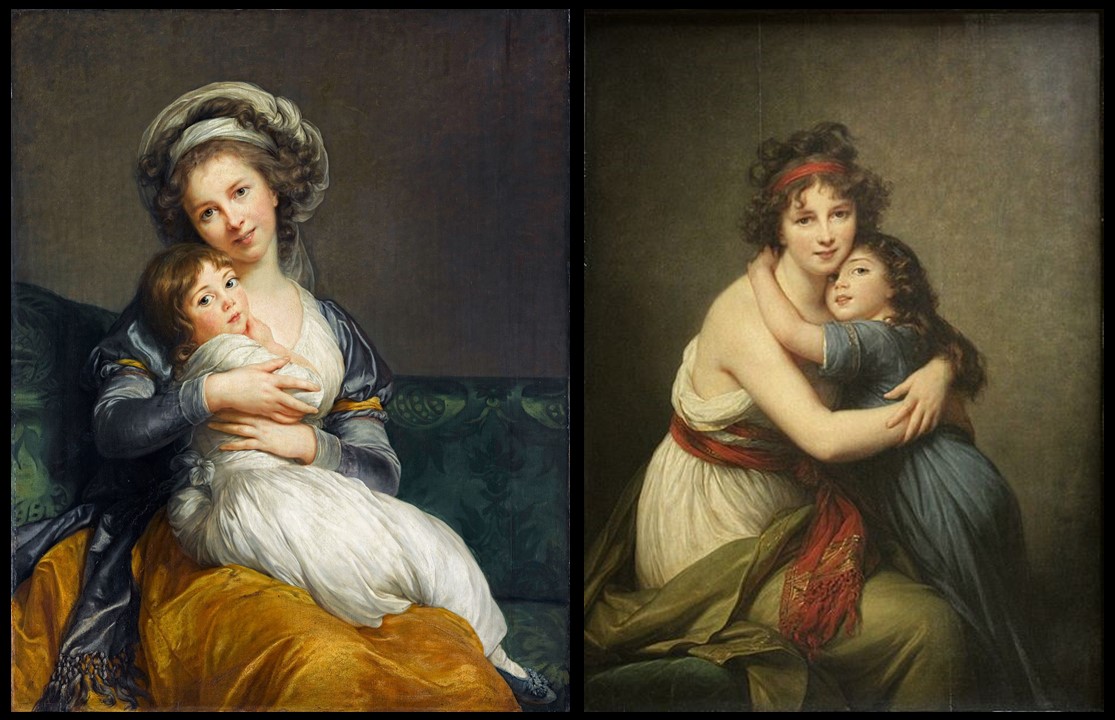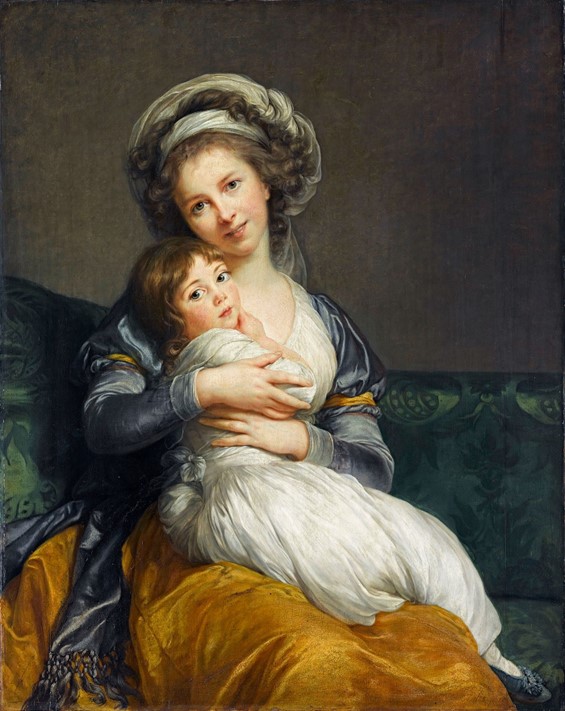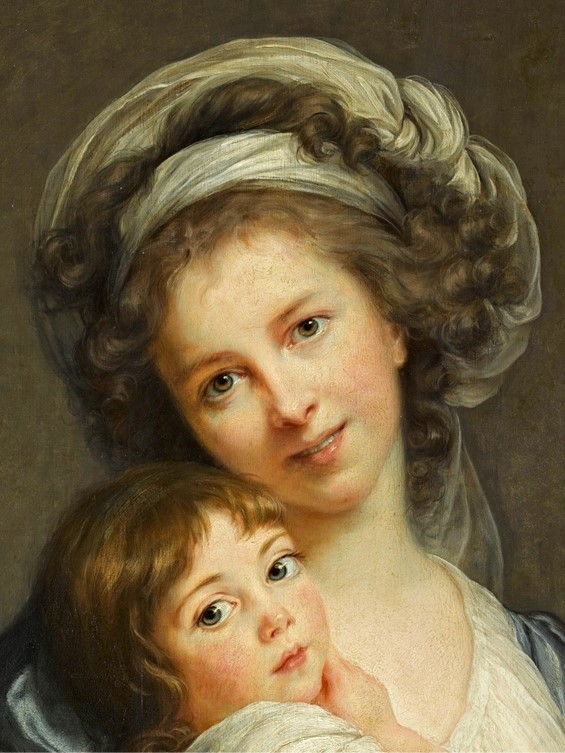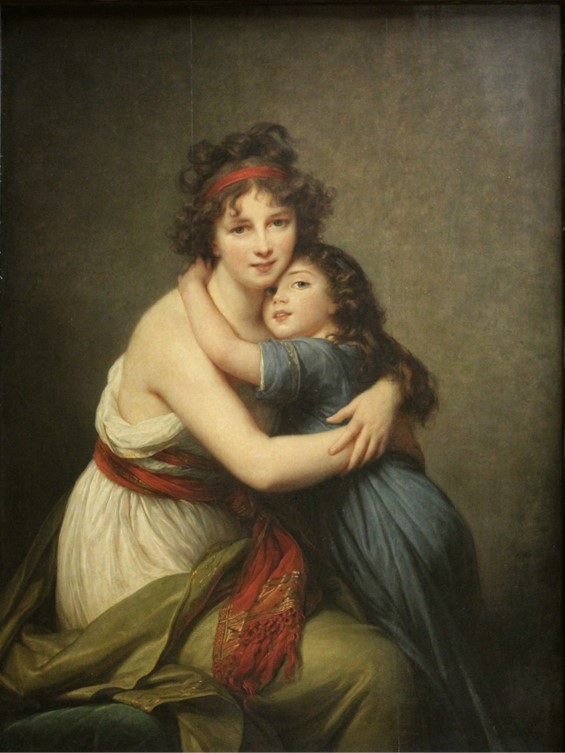
Self-portrait with Her Daughter, Julie, 1786, oil on panel, 105 × 84 cm, the Louvre, Paris, France https://histoire-image.org/etudes/nouveau-visage-amour-maternel
Self-Portrait with Her Daughter, Julie (à l’Antique), 1789, oil on canvas, 130×94 cm, the Louvre Museum, Paris France https://commons.wikimedia.org/wiki/File:Self-portrait_with_Her_Daughter_by_Elisabeth-Louise_Vig%C3%A9e_Le_Brun.jpg
Sonnet IV by Victorian Poet Augusta Davies Webster, the Victorian Poet, reads… ‘Tis but a child. The quiet Juno gaze / Breaks at a trifle into mirth and glow, / Changed as a folded bud bursts into blow, / And she springs, buoyant, on some busy craze, / Or, in the rhythm of her girlish plays, / Like light upon swift waves floats to and fro, / And, whatsoe’er’s her mirth, needs me to know, And keeps me young by her young innocent ways. / Just now she and her kitten raced and sprang / To catch the daisy ball she tossed about; / Then they grew grave, and found a shady tree, / And kitty tried to see the notes she sang: / Now she flies hitherward–“Mother! Quick! Come see! / Two hyacinths in my garden almost out!” Presenting two paintings of Élisabeth Louise Vigée Le Brun with Her Daughter, Julie is my humble contribution to May 14, and Mother’s Day! https://allpoetry.com/Mother-and-Daughter–Sonnet-Sequence
Élisabeth Louise Vigée Le Brun (1755-1842) was a French portrait painter who became one of the most celebrated artists of her time. Born in Paris, she was the daughter of a painter, Louis Vigée, and began studying art at a young age. She showed a remarkable talent for portraiture, and by the age of fifteen, she was supporting herself and her family through her art. In 1776, Vigée Le Brun married a wealthy art dealer named Jean-Baptiste-Pierre Le Brun, which helped to expand her social and professional networks. She soon became a favorite painter of the French aristocracy, including Queen Marie Antoinette, whom she painted numerous times.
During the French Revolution, Vigée Le Brun fled France due to her close association with the royal court. She spent several years traveling throughout Europe, painting portraits of various members of the nobility and aristocracy. She eventually settled in Russia, where she became a favorite painter of Catherine the Great. After the fall of Napoleon and the restoration of the French monarchy, Vigée Le Brun was able to return to France. She continued to paint portraits and exhibited her work regularly at the Paris Salon. She was also an accomplished writer, publishing several memoirs that detailed her life and career.
Vigée Le Brun’s art is known for its refined elegance and sensitivity to the individual character of her subjects. She painted many of the leading figures of her time, including royalty, politicians, and artists, and her work is now housed in museums and collections around the world. She was a pioneer for women in the male-dominated world of art, and her legacy as a ground-breaking female artist continues to inspire generations of artists today.

Self-portrait with Her Daughter, Julie, 1786, oil on panel, 105 × 84 cm, the Louvre, Paris, France https://histoire-image.org/etudes/nouveau-visage-amour-maternel

Self-portrait with Her Daughter, Julie (detail), 1786, oil on panel, 105 × 84 cm, the Louvre, Paris, France
https://www.facebook.com/museedulouvre/photos/naissance-de-%C3%A9lisabeth-louise-vig%C3%A9e-le-brun-birth-of-%C3%A9lisabeth-louise-vig%C3%A9e-le-b/10154657162619926/
In 1786, Élisabeth Louise Vigée Le Brun painted her first Self-Portrait with her daughter Jeanne Julie Louise, whom she called Julie, and caused a scandal! She presented herself holding her child most affectionately, looking straight to the viewer and smiling with her lips parted and her teeth showing. The 1787 gossip sheet ‘Mémoires secrets’ wrote… An affectation which artists, art-lovers and persons of taste have been united in condemning, and which finds no precedent among the Ancients, is that in smiling, [Madame Vigée-Lebrun] shows her teeth. Yet, Count of Angiviller, director general of the King’s Buildings, liked her Self-Portrait, as exhibited in the Salon of 1787, and requested that the artist paint a second version of the same subject. In 1789, Élisabeth Louise Vigée Le Brun complied and presented Self-Portrait with Her Daughter, Julie (à l’Antique). https://histoire-image.org/etudes/nouveau-visage-amour-maternel

Self-Portrait with Her Daughter, Julie (à l’Antique), 1789, oil on canvas, 130×94 cm, the Louvre Museum, Paris France https://commons.wikimedia.org/wiki/File:Self-portrait_with_Her_Daughter_by_Elisabeth-Louise_Vig%C3%A9e_Le_Brun.jpg
Both paintings by Vigée Le Brun are beautiful examples of the artist’s work and a significant representation of the Late Rococo Style. The paintings are notable for their emotional depth and the strong depicted bond between mother and child. They are a testament to the artist’s skill and her ability to capture the essence of her subject in a way that is both truthful and beautiful.
For a Student Activity, please… Check HERE!